Katherine Owens, Undermain Theater Co-Founder, Avant-Garde Pioneer, Has Died
ArtandSeek.net July 23, 2019 65If North Texas had lacked any history of daring dramas onstage, Katherine Owens would have invented it herself – in a leaky concrete cave. With no seats and no curtains. With little heat and a ceiling so low you could barely put up theater lights and not crack your head.
Owens helped create North Texas’ alernative theater scene and along the way, took her Undermain Theatre company to Europe and New York and commissioned world-premieres from some of the country’s leading, out-on-the-edge playwrights. The 61-year-old Dallasite died Saturday of lymphoma. Since May, she’d been receiving chemotherapy treatments at the Baylor T. Boone Pickens Cancer Center but eventually suffered kidney failure and pneumonia. The last production Owens staged at the Undermain was the final part of Matthew Paul Olmos’ trilogy, ‘so go the ghosts of méxico’ in April, but she needed help to finish it.
Even if you never set foot in a theater, you probably have heard Owens: In addition to all her work running the Undermain, she was a voice actor, including for KERA. She recorded on-air promotions and narrated documentaries for the station since the mid-’80s.
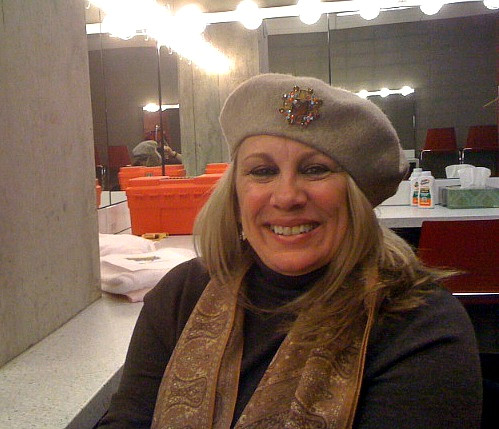
Katherine Owens, backstage at the Moody Performance Hall, 2014. Photo: Jerome Weeks
Thirty-five years ago, Owens and co-founder Raphael Parry established what may have been North Texas’ first, literally underground theater. They christened it the Undermain because its home was – and still is – a basement in Deep Ellum at 3200 Main. The six-story, red-brick building began life as a US Customs warehouse. A fitting origin, considering what Owens, Parry and their ensemble of actors and designers would import to North Texas.
Owens was an adopted child, who grew up in the oil patch – Odessa, Texas, where her father Jack encouraged her creativity. At 12, she saw a local production of the comedy, “Life with Father,” at the Permian Playhouse – and her fascination with theater began. Soon she started working as an intern at Odessa’s Globe Theatre. When she graduated from UT-Austin and finished a residency directing at the Oklahoma Shakespeare Festival, she moved to Dallas in 1982. There, she met Parry – another acting-school grad looking for work. He cast her in a production of “Lysistrata” that he’d co-financed at the Bath House Cultural Center. It was only the second stage show put on there.
“Artistically, the production was successful,” says Parry, the current executive director of Shakespeare Dallas. “But financially, a disaster. We lost the $10,000 we’d borrowed, and I was an indentured servant. But Kat and I became friends.”
Together, at her apartment, they started work on another show, Sam Shepard’s 1975 solo, “Killer’s Head.” They eventually presented it at one of the area’s few adventurous theaters at the time: Stage Number One, then housed on Lower Greenville.
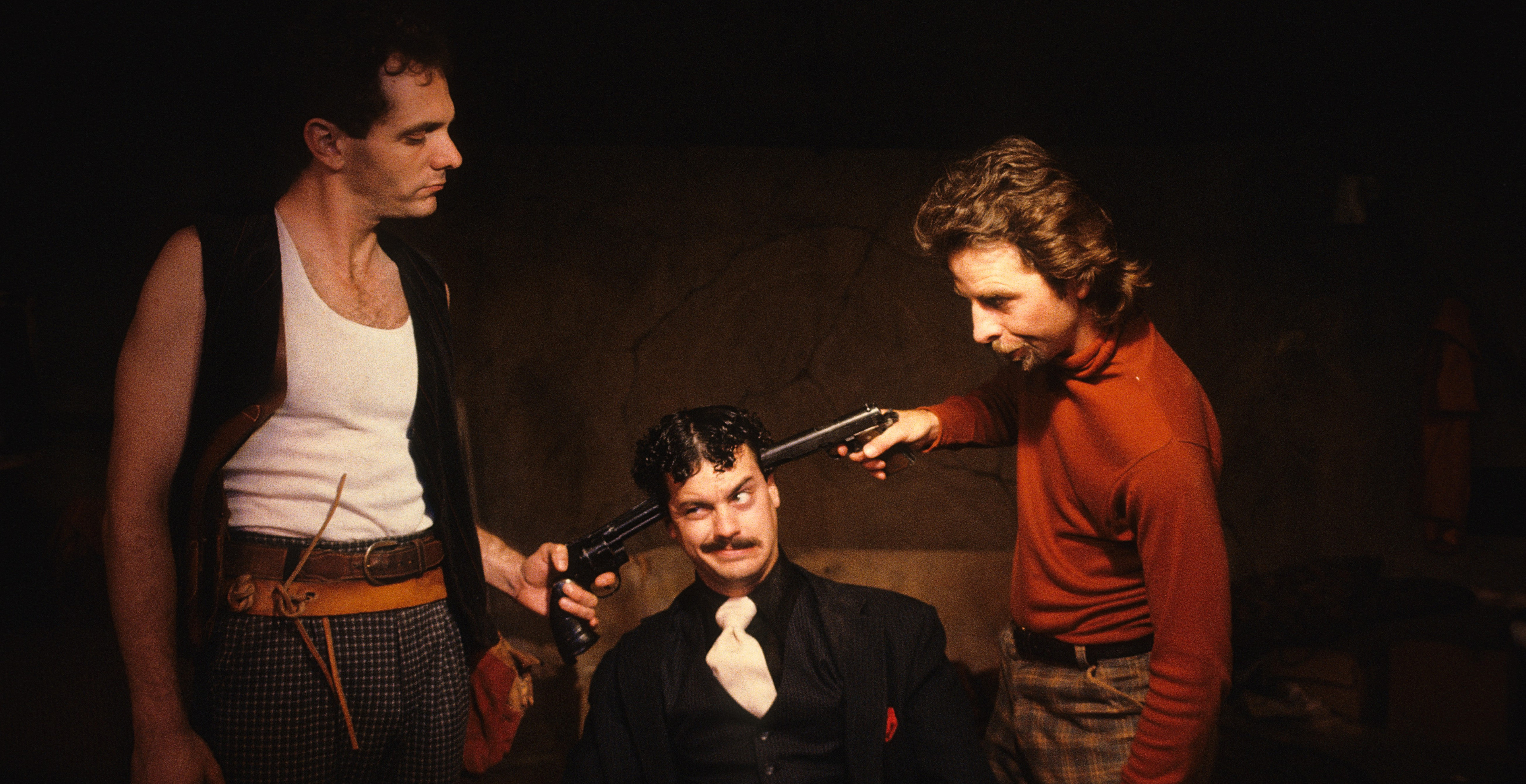
Bruce DuBose, the late Ted Davey and Undermain’s then co-director Raphael Parry in David Rabe’s “Goose and Tomtom’”in 1989. Photo: Undermain Theatre
But having scouted for a year for a rehearsal space the two of them could rent, the determined Owens finally found a trash-filled basement on Main Street. She and Parry never intended it as a performance venue. But a Deep Ellum street fair was coming up, so the two cleared out some of the boxes and staged their first independent production, fittingly called “Excavations.” It was a trilogy of Sam Shepard solos. Parry and Owens had to switch back-and-forth between performing and managing the lights. It was staged promenade-style because the place had no seating – just a Persian rug the two had found thrown out on the street. Parry and Owens had to name their space and couldn’t come up with anything other than what it was: Undermain.
From such a scrappy, thrown-together start, it was ironic that eventually, the Undermain would pay to have the original Frank Lloyd Wright-designed seats at the Kalita Humphreys Theater refurbished and restored. They’d been removed in 1983 because of renovations. The seats were proudly installed in the Deep Ellum basement in 2010. It was a sign: Thanks in great part to Owens’ leadership, the Undermain had come to embody some of the best of North Texas theater history.
How that happened took a unique, fleeting confluence that may never happen again: the right people (hungry, talented), the right timing (the ’80s), the right neighborhood (post-industrial), the right performance space (raw), the right real estate economy (bad), the right kind of theater on stage (adventuresome) – and the right artistic leadership.
In 1984, Deep Ellum was the Wild West for North Texas artists and musicians. They were filtering in for the cheap rents and the chance to turn vacant, disused spaces into studios, nightclubs and performance venues. Thanks to the oil bust and the savings-and-loan scandal that triggered a mid-’80s recession in Texas, the plans to bulldoze much of Deep Ellum and put up apartments got shelved (for three decades). As an unintended consequence, Dallas enjoyed probably its only true ‘wave’ of theater start-ups. It may have been the last time the city has ever had usable spaces ordinary artists could afford. It effectively transformed North Texas theater by creating, not just an interesting company or two. It showed there was something of an audience here (and the talent) for an entire ‘alternative’ theater scene.
So Dallas theater history divides into pre-Deep Ellum in the ’80s and post-Deep Ellum in the ’80s. And that means pre- and post-Katherine Owens.

Katherine Owens and Bruce DuBose in Neil Bell’s ‘Two Small Bodies’ in the Undermain’s fifth season. Photo: Undermain Theatre
Still, of all the promising troupes from the mid-’80s – The Deep Ellum Theatre Garage, the Commerce Street Theater, Pegasus Theatre, the Exposition Street Theatre – Undermain is the only one to remain in Deep Ellum. And it thrived – on its own terms. Undermain became nationally known as an engine for accomplished, ambitious, provocative theater. Owens herself would go on to direct plays in New York, Macedonia and Yugoslavia – as well as become a member of the Sundance Institute in Utah, where she workshopped “Jonah,” a script by playwright Len Jenkin, a long-time Undermain collaborator. In fact, his wife, Dr. Ramona Jenkin, was personally involved with Katherine’s medical care the past several months.
The survival and success of Undermain had much to do with Owens’ own strengths, says Giva Taylor, a longtime costume designer with the company: “She had administrative skills not normally considered in the artistic realm. She was very good at hiring people. You could see the strength she had in dealing with money, donors, audience relations. She was remarkably strong.”
When they started in Dallas, Owens and Parry were worried the city was far too conservative for the kind of risky theater they hoped to create. But they also worried they weren’t good enough yet to be really seen.
“We didn’t invite any critics at the beginning,” Parry says, “so we could just figure out how to do our art correctly on our own. But I think that turned out to be one of the smartest things we did. We became kind of a little secret in Deep Ellum.”
In Undermain’s first struggling years, it showcased such boundary-breakers as Samuel Beckett, Dario Fo and Harold Pinter. They were already well established names (and some of their works had been staged in Dallas before by Stage Number One and Theatre Three). But they still were out-on-the-edge by North Texas standards, especially as a theater’s main offerings (one play each by Pinter and John Guare were as mainstream as the company got in its early days). During its second year, the Undermain even staged a company-created, performance art work, “Security Anxiety,” at the Dallas Museum of Art – the first theater to do so.
In their first year, Owens and Parry also spotted another promising actor at Stage Number One and asked him to make their duo a trio. Bruce DuBose would become the ensemble’s leading performer, its executive producer – and Owens’ life partner. Owens and DuBose would eventually be married in 2000. Entire shows have been built around DuBose’s talents as an actor, musician, director and sound designer – including the world premiere of DuBose’s stage adaptation of Neil Young’s rock opera, “Greendale” in 2008 – which Owens directed. The company took it to the off-off-Broadway Ohio Theatre in New York City (Owens eventually directed several shows there).
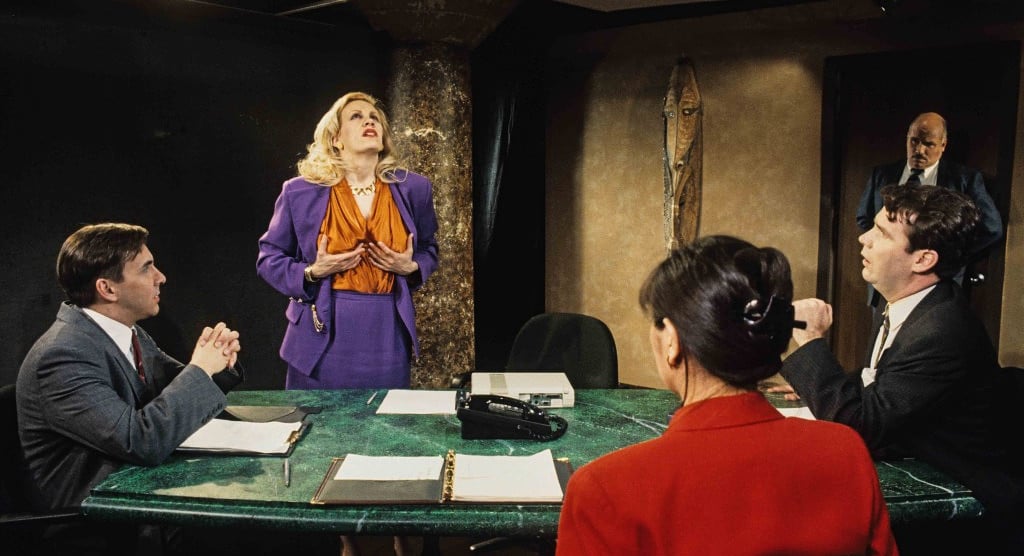
Dennis Milleganl, Katherine Owens, Lisa Lee Schmidt, Tom Lenaghen and Robert Erwin in ‘Tiny Dimes’ in 1995. Photo: Undermain Theatre.
When she moved to Dallas, Owens didn’t realize the city had actually been a theater leader before: She was joining a historical line of female company heads that included Margo Jones, who established the American resident theater movement in Dallas in 1947, and Norma Young, co-founder of Theatre Three in 1961.
“The first thing I always think about with Kat,” Parry says, “was her intellectual capacity. Her knowledge base and her continued study pushed all of us. And being a woman was really seminal in that. Her guiding light was it had to be the best we could make it, and she was fearless in the pursuit of that.”
Parry recalls an early guest director not producing work that met Owens’ standards. She fired him and shut the show down.
Since Owens helped establish the Undermain in 1984, North Texas has become a hub for women artists leading theater troupes. Just a sampler: Dana Schultes (Stage West), Teresa Coleman Wash (Bishop Arts Theatre), Susan Sargent (WingSpan Theatre), Tina Parker (Kitchen Dog), Cora Cardona (Teatro Dallas), Kateri Cale (Echo Theatre) and Soul Rep co-founders Tonya Davis-Holloway, Anyika McMillan-Herod and Guinea Bennett-Price. Owens often spoke publicly about the need for female mentorship and leaders. Through her efforts, fifty percent of the entire Undermain ensemble continues to be women, and the company has staged works by Suzan-Lori Parks, Sarah Kane, Young Jean Lee and other women playwrights.
The ‘co-artistic directorship’ of both Owens and Parry in running Undermain was also unusual. “We always called it a ‘benevolent monarchy,’” says Parry. “In fact, I think it was Kat who invented that phrase.”
But collaborating like that was Owens’ mode of operating, Taylor says. As a director, she was extremely open. She did not come into rehearsals with her own Big Inspirations everyone had to sign on to. She was relaxed, sat with her cup of herbal tea. She was confident her people would address things that might not work – and then, if necessary, she’d take charge.
“I’ve seen her throw out every bit of choreography, every bit of staging a week before a show opened,” Taylor says. “It took her awhile, I think, to see what she wanted to see. She listened a lot and she watched a lot. But she was willing to go with everyone as long as she possibly could before she finally went in and said, ‘OK, this is what we’re going to do.’”
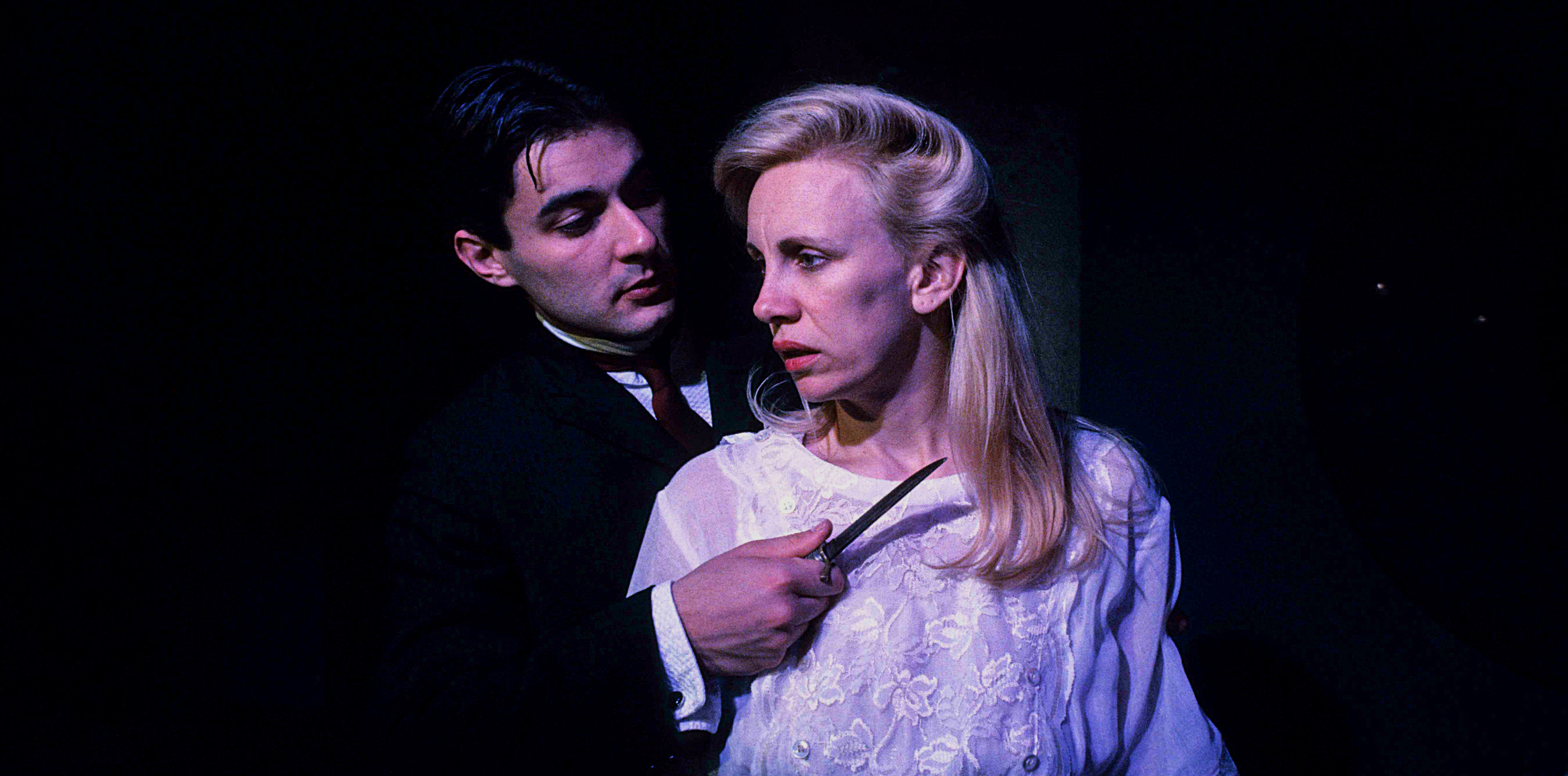
Jeffrey Schmidt (now artistic director of Theatre Three) and Katherine Owens in Erik Ehn’s world premiere adaptation of William Faulkner’s “The Sound and the Fury” in 1991. Photo: Undermain Theatre
As a performance facility, the Undermain’s crumbling cavern has its serious limitations: the incredibly low ceiling, the fat pillars that block sightlines and the cramped floorspace that can accommodate 80 audience members, max. But it also gave Owens and her company instant avant-garde credibility and atmosphere, the immediate sense, to anyone walking down the worn stairs, that they were being transported to some gritty arts hangout in Greenwich Village or West Berlin.
“I remember someone saying,” Parry recalls, “going down those stairs was like stepping into the unconscious.”
It automatically made Undermain unlike anything else in North Texas. The Undermain specialized in sophisticated European ironists, such as Caryl Churchill and Howard Barker, and off-off-Broadway American dramatists, word-drunk and unfettered by stage conventions: Len Jenkin, Mac Wellman, Erik Ehn, Lynn Alvarez, Jeffrey M. Jones and John O’Keefe. The company often presented the Texas premieres of their dramas, even the world premieres. Ultimately, the Undermain started to commission works from them and publish their scripts. In particular, the regional premiere of David Rabe’s ‘Goose and Tomtom’ in 1989 established a relationship with the Tony Award-winning playwright – which led to two of his other plays being staged there, “The Black Monk” and “The Dog Problem.”
Owens’ long-term influence on North Texas theater lay in her boldness, Taylor says. “She gave people a lot of permission to do things they’d not otherwise do because the Undermain was successful doing it. It was always interesting. You never knew what you were going to get.”
Unlike most venues, the Undermain, at times, could feel like it wasn’t even a theater. With her playwrights and designers, Owens transformed that dank space and its industrial columns into ancient temples, fairy tale castles, a suburban basement, a devastated wasteland, Faulkner’s South, Chekhov’s Russia. And in doing all that, the Undermain attracted an ensemble of actors and designers equally ready to work out on a ledge: Rhonda Boutté, Lisa Lee Schmidt, Laurel Hoitsma, Ted Davey, Robert Winn, Robert McVay, Kateri Cale, Tom Lenaghen, Robert Erwin, Ivan Klousia, Fred Curchack, Anthony Ramirez, Blake Hackler, Paul Semrad.
“She had actors she trusted and loved,” Taylor says. “Again, she was collaborative – perhaps more collaborative than anyone I’ve worked with.”
And Undermain productions didn’t play around when it came to pushing boundaries or offending patrons. They went beyond just violence or Owens’ nude witches in “Macbeth.” John O’Keefe’s “The Deatherians” included on-stage, simulated masturbation and ejaculation. Peter Barnes’ “Laughter!” – directed by Parry – was a comedy about Hitler and the Holocaust that included corpses being hauled from a hellish oven. In 2010, Owens presented the North Texas premiere of the gender-transgressing playwright-performer Taylor Mac. He recently debuted on Broadway with his blood-soaked comedy,”Gary: A Sequel to Titus Andronicus.” He was nominated for a Tony Award as best playwright.

Katherine Owens in Howard Barker’s ‘The Castle’ in 1993. Photo: Undermain Theatre
As a director, though, Owens proved she wasn’t in the theater for easy shocks. In 1995, she and the Undermain company were invited to tour Macedonia with “Sarajevo,” Goran Stefanofki’s drama about the capital of Bosnia that was then still under siege. They eventually performed it in an ancient Roman amphitheater and on the steps of a cathedral. In 2001, Owens returned to Europe to present a performance of “Judges 19” at a theatre festival in Serbia.
In Dallas, Owens directed a Butoh-influenced “Macbeth” that still stands as one of the starkest, most imaginative re-imaginings of a Shakespearean classic in area history. And in the past decade, she put together a stellar artistic team with the Tony Award-winning set designer John Arnone, lighting designer Steve Woods and costumer Giva Taylor. Together, they significantly elevated the Undermain’s production quality to create such hallucinatory theatrical experiences as Len Jenkin’s “Port Twilight” and ‘Time in Kafka.”
But by 1998, co-founders Owens and Parry parted ways over the future direction of the company. Parry had come to enjoy working in the Undermain’s second venue, a taller, more expansive Elm Street space – a space that could be economically viable, unlike the basement, which would always be dependent on grants because of its extremely limited size and ticket sales. Parry had also begun directing Shakespeare. Plus, married with a young child, he wasn’t interested in Owens’ plans for the future of the company, which included establishing a New York base for six months each year.
“We had basically taught each other how to be directors,” Parry says. “And part of it was that whole arc of two artists who worked together collaboratively for years and then discover their own independence. And we couldn’t come to an agreement on what to do next. Who was going to take the lead? And I decided it was me who needed to leave.”
At the time, Parry says, the split felt like a bitter divorce. It was a shock to the Dallas theater community. Some actors and designers chose sides and left as well. In 2002, Parry took on the reins at Shakespeare Dallas, and the two eventually patched up their differences There have even been reunions of original Undermain ensemble members.
Because of Owens’ family, she’s been able to weather the typical, cash-flow crises that sink many smaller, adventurous stage companies. She and DuBose have maintained an apartment in Brooklyn, for instance – which has been an asset when it’s come to collaborating with New York-based artists and for keeping tabs on the latest imports from abroad.
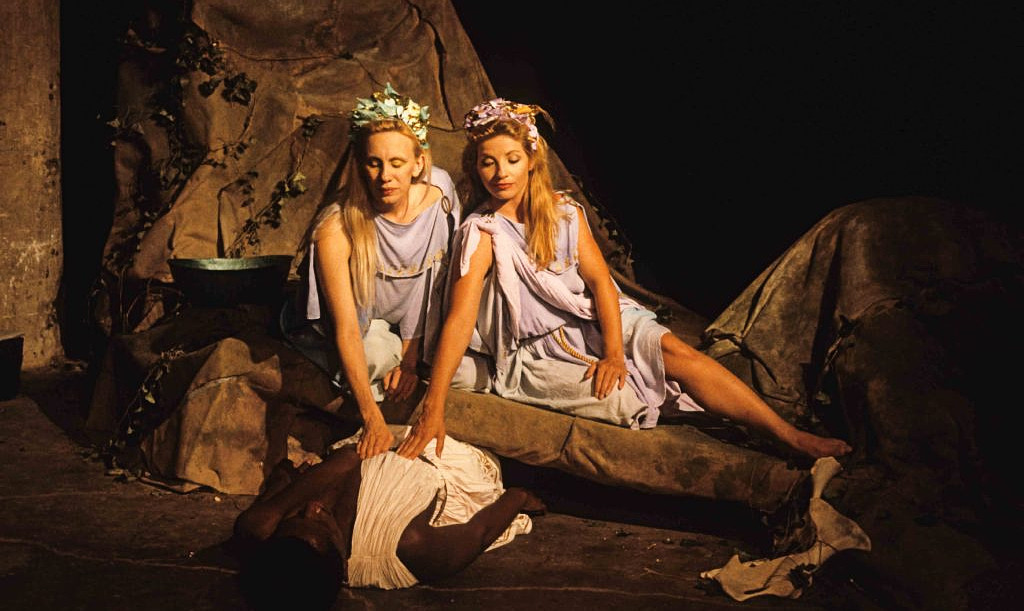
“Venus and Adonis,” directed by the late Ted Davey, starring Katherine Owens, Nathan Hinton and Sara Weeks in 1991. Photo: Undermain Theatre
As with their early effort at the DMA, the Undermain became the first theater company to perform in the Arts District in 2010 at Dallas’ new Moody Performance Hall (then called City Performance Hall): They staged Irish playwright Enda Walsh’s “Penelope.” Typically, they did it in a highly unconventional way. Director Stan Wojewodski closed off the entire seating area in the auditorium and used just the stage as the theater, complete with the audience there.
Staging a show in the Arts District was a deliberate gesture: The Undermain could play alongside the biggest of the big boys, the Dallas Theater Center and the Dallas Opera. But the project was so sizable for them, they had to rent a semi-trailer to haul the set to the performance hall. It was probably the only midsize North Texas troupe that could pull off such a feat.
While most North Texas theaters won’t venture into the classics beyond Shakespeare, a few Greeks or the occasional “Importance of Being Earnest,” the Undermain in recent years decided to explore the origins of modern theater by staging such once-scandalous, nearly forgotten dramas as August Strindberg’s “The Ghost Sonata” and Bertolt Brecht’s “Galileo.” The company that began three decades ago wondering if they’d offend area theatergoers has become one of our best – one of our only – champions of the continued relevance of avant-garde classics. Directed by Owens, their production of Strindberg’s “Easter” was the first time the 1901 drama had ever been staged in North Texas. For the upcoming season, Owens was scheduled to work with award-winning playwright Adrienne Kennedy to premiere a new, ambitious stage adaptation of “Madame Bovary,” Gustav Flaubert’s groundbreaking, 19th-century novel of infidelity and provincial life.
In Undermain’s early days, company members often traded and tried out different duties – working as director or actor or designer. Owens once complained she didn’t know why everyone seemed to think directing was so hard. It seemed to come naturally to her. It was acting she found so challenging. Owens often didn’t seem fully comfortable, fully present playing someone else. There was always that mind clearly working, the intelligence that couldn’t help but see three steps ahead. By the mid- ’90s, she’d stopped performing onstage.
Instead, she took on the role of the theater’s public face – in the lobby, before the show, welcoming people, introducing plays.
“I credit her hospitality and grace,” says Taylor. “When you came to the Undermain, you always felt welcome. She’d welcome you with great joy. Of course, they might beat you up a little bit with the play, but you were definitely invited to be there.”
At the same time, offstage, Owens had become a significant presence in North Texas arts: a juror for the Asian Film Festival, a recipient of the American Association of University Women’s Texas Woman of Distinction Award, the 2013 Dallas Historical Society Award for Excellence in the Creative Arts and a fellow of the Dallas Institute of Humanities and Culture. She was a liaison with Booker T. Washington High School for the Visual and Performing Arts.
She was also the voiceover talent in several documentaries including Mark Birnbaum’s “Las Mujeres de Valle” and Judy Kelly’s “Frozen Music” from KERA – about the creation of the Meyerson Symphony Center, which won an Emmy and a Matrix Award.
Owens is survived by DuBose, her sister Kimberly and her brother Carl Robert Owens.
Arrangements for a memorial service will be announced on the Undermain’s website..
Gin and Tonics: Raphael Parry on how he and Katherine Owens first operated the Undermain Theatre as a two-person company:
Rat Runs: Raphael Parry on how the Undermain ensemble worked in its early years:
Knuckles and Intellect: Raphael Parry on how Katherine Owens and he worked as co-artistic directors and what kind of leadership Owens provided.
Always Endeavoring: Giva Taylor on Katherine Owens as an artist:
Credit: Giva Taylor on Katherine Owens as an administrator – and a public presence:









